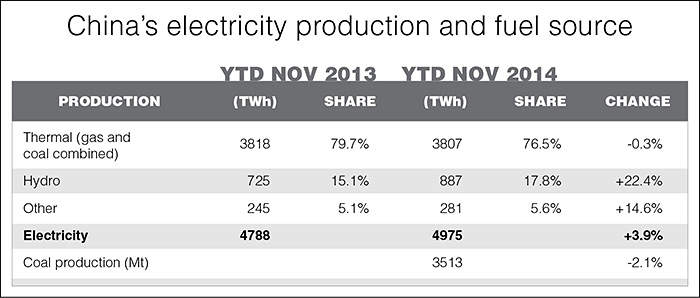The latest energy-market numbers from the Chinese government show an acceleration of a remarkable phenomenon that emerged from 2012 to 2014. The bottom line today is that the traditional nexus between real gross domestic product (GDP) growth, electricity expansion and coal demand is now broken.
Demand for coal in China grew by 10% annually over the decade to 2011, but that halved to between 4% and 6% annually in 2012 and 2013. In 2014, according to the most recent government figures, demand actually declined by 2.1%.
This is no small thing for global coal markets, and the implications are enormous.
The latest data are consistent, however, with the Institute for Energy Economics and Financial Analysis (IEEFA)’s prediction last fall that China’s demand for coal will permanently peak by 2016 — if not earlier — and gradually decline thereafter.
Digging further into the most recent trove of economic data from Beijing helps explain what’s happening.
China’s overall GDP growth in 2014 is expected to yield the same 7.3% growth reported for the first nine months of the year. But China’s electricity demand, as seen in the newest numbers, grew by only 3.9% year-over-year through November. What these two figures show in tandem is that the combined impact of energy efficiency initiatives and structural economic changes toward less electricity-intensive industry sectors has reduced the ratio of electricity demand growth to GDP from above 1.0x over the past 13 years to 0.53x in 2014.
This is a shift that has not gone unnoticed by Wall Street analysts. This past August, for instance, Morgan Stanley halved its outlook for China’s electricity demand to GDP ratio from 2014 to 2016, forecasting that it will register at somewhere between 0.3 and 0.5x over the medium term, signalling a fundamental shift in the Chinese energy economy. The IEEFA has forecast a ratio of 0.6x for 2014 to 2020 — an estimate that may, if anything, prove conservative.
Of equal importance is that China’s domestic coal production declined by 2.1% in the year to November compared to 2013, while coal imports were down by 9%, meaning that coal consumption dropped 2.3%. This contrasts with a 3.9% electricity production growth rate year-over-year, reflecting a rapid loss of market share for coal in 2014 against all other sources of electricity generation across China — i.e., hydro, wind, solar, nuclear, natural gas and biomass.
The rise of renewables in China is significant. IEEFA forecasts that in 2014 alone, China will install 22 gigawatts of hydropower electricity capacity, 18 gigawatts of wind-powered capacity, 13 gigawatts of solar, 5 to 7 gigawatts of nuclear, and 4 to 6 gigawatts of gas-fired capacity. Combined with 22 gigawatts of net new coal-fired capacity, IEEFA sees China’s total electricity capacity installs totalling 90 gigawatts in 2014 — a more than 6% year-over-year increase in total capacity growth.
The result is that coal-fired average use rates have declined from an estimated 60% in 2011 to 56% in 2014. Given this excess capacity, new installations of coal power are expected to slow rapidly, and China could see reduced net annual coal-fired power capacity from 2016 onwards.
IEEFA has coal’s share of electricity production in China dropping from the 78% to 79% average recorded from 2008 to 2011, to 72.5% in 2014. IEEFA sees that number falling to 60% by 2020, as China’s rapid diversification into lower-carbon alternatives gains steam.
We see it as no coincidence that China has announced two major policy moves that together suggest dramatic change or deterioration in the outlook for the global seaborne thermal coal market. China has moved explicitly to reduce coal export tariffs from 10% to 3% starting in January 2015. This follows the announcement in October 2014 that Beijing will impose a 6% import tariff on thermal coal (unless sourced from Indonesia, under the Asian bilateral free trade agreement). China was a net coal exporter before 2009, and IEEFA expects it could reclaim that status later this decade.
Add to all these numbers Chinese press reports in December suggesting that Chinese government is considering an end to approvals for new coal-to-gas (CTG) and coal-to-oil (CTO) projects as part of its next five-year plan for the industry. Given that the government had previously proposed a massive CTG and CTO program that would have required another 300 million tonnes of coal production annually, such a move would further erode the last main area of potential new growth for China’s domestic coal industry.
All of this is occurring at a time in which solar-efficiency records are being set every month, all around the world.
IEEFA stands by its forecast that global coal markets will mirror Chinese coal markets and that peak demand for coal will occur by 2016 globally, with a structural decline thereafter. These trends, combined with recent changes in currency markets and continued oversupply as new mines are pushed online, indicate that stranded assets associated with proposed greenfield coal-export mines and related infrastructure development remain an especially acute financial risk.
— Tim Buckley is IEEFA’s director of energy finance studies for Australasia. He has 25 years of financial markets experience, having spent most of this time as a top-rated equities research analyst in Australia, covering global and Asian equity markets. Buckley is co-founder and managing director of Arkx Investment Management, an investor in leading global-listed clean energy companies. He was with Citigroup for 17 years, culminating in his role as managing director and head of Australasian Equity Research for the last six years.
Based in Cleveland, Ohio, the IEEFA conducts research and analyses on financial and economic issues related to energy and the environment. The Institute’s mission is to accelerate the transition to a diverse, sustainable and profitable energy economy, and reduce dependence on coal and other non-renewable energy resources. See www.ieefa.org for more information.





Be the first to comment on "Commentary: China’s declining coal dependence"